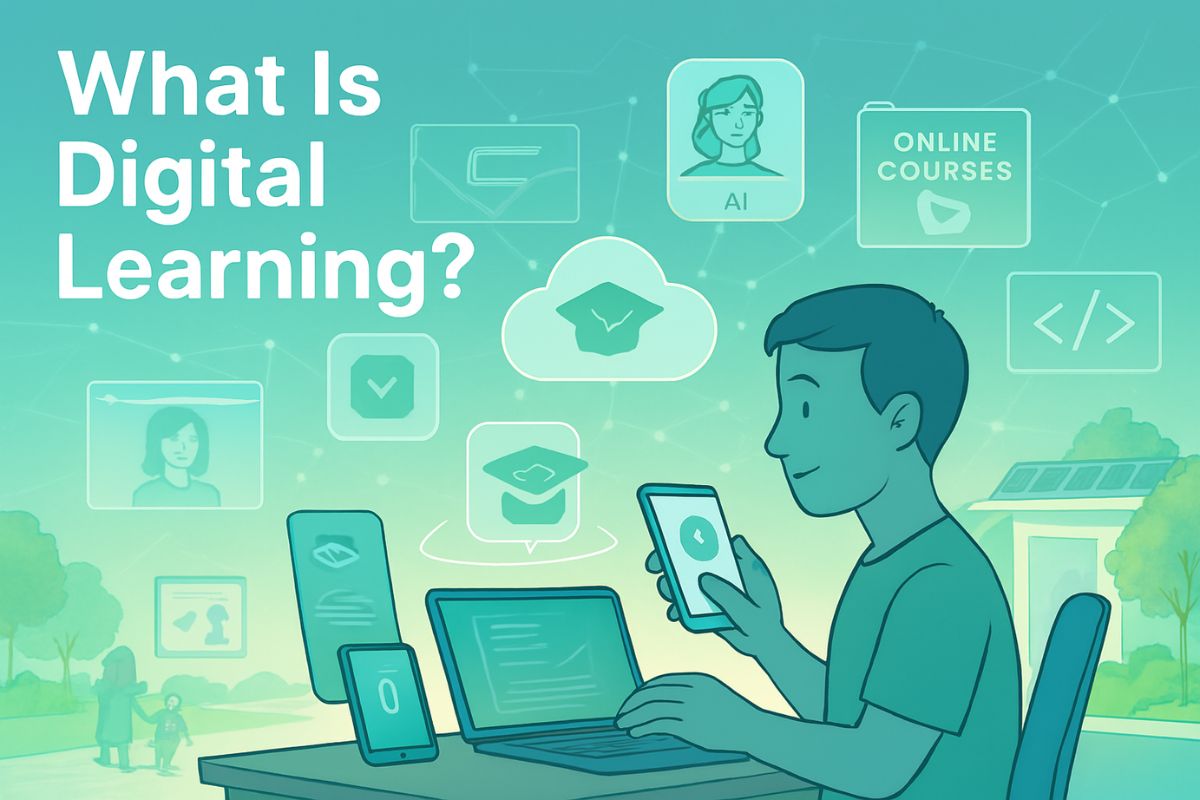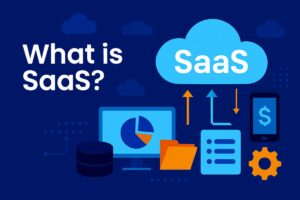- Definition: Digital learning uses technology to enhance education, making it accessible, flexible, and interactive.
- Key Benefits: Personalized learning, flexibility, cost-effective, global access.
- Popular Tools: Learning Management Systems (LMS), virtual classrooms, AI-powered learning apps.
- Challenges: Digital divide, tech issues, screen fatigue, data privacy.
- Future Trends: AI integration, VR/AR learning, personalized adaptive learning paths.
In today’s fast-paced world, education has broken free from the traditional boundaries of classrooms and textbooks. The question on many curious minds is: What is digital learning? Whether you’re a student, teacher, parent, or lifelong learner, understanding digital learning is essential to thrive in this technology-driven era.
This blog dives deep into what digital learning means, how it works, its pros and cons, and what the future holds. By the end of this guide, you’ll have a crystal-clear understanding of digital learning and how you can make the most of it.
What Is Digital Learning?
Digital learning is the use of technology to deliver education and training. Unlike traditional classroom learning, digital learning takes place over the internet or using digital tools. It includes online courses, e-learning platforms, virtual classrooms, mobile apps, interactive simulations, and even AI-powered learning assistants.
Simply put, digital learning leverages the power of digital devices and online resources to make education more accessible, flexible, and engaging.
Core Components of Digital Learning
- Content Delivery: Videos, e-books, podcasts, webinars.
- Interactive Tools: Quizzes, polls, discussion forums.
- Collaboration Platforms: Zoom, Google Meet, Microsoft Teams.
- Assessment Tools: Online exams, progress tracking, instant feedback.
Why Is Digital Learning Gaining Popularity?
Several factors contribute to the rapid rise of digital learning:
- Flexibility: Learn anytime, anywhere.
- Cost-Effectiveness: Save on travel, accommodation, and materials.
- Personalization: Adaptive learning paths tailored to individual needs.
- Global Access: Connect with experts and peers worldwide.
- Technology Advancement: AI, VR, AR, and gamification make learning fun and effective.
Types of Digital Learning
1. Synchronous Digital Learning
- Live classes via Zoom, Google Meet.
- Real-time interaction with instructors and peers.
2. Asynchronous Digital Learning
- Pre-recorded videos, reading materials.
- Learn at your own pace.
3. Blended Learning
- Combines online and face-to-face learning.
- Best of both worlds.
4. Massive Open Online Courses (MOOCs)
- Platforms like Coursera, Udemy, edX.
- Open access to courses from top universities.
5. Microlearning
- Bite-sized lessons.
- Ideal for busy professionals.
6. Gamified Learning
- Uses game elements like points, badges, and leaderboards.
- Boosts engagement and motivation.
Benefits of Digital Learning
| Benefit | Description |
|---|---|
| Flexibility | Learn anytime, anywhere. |
| Accessibility | Resources available globally. |
| Personalized Learning | Customized learning paths. |
| Cost Savings | Reduces overhead costs. |
| Instant Feedback | Immediate assessments and corrections. |
| Updated Content | Access to the latest information. |
Challenges of Digital Learning
While digital learning offers numerous advantages, it’s not without challenges:
- Digital Divide: Lack of internet access in rural areas.
- Technology Barriers: Not all students are tech-savvy.
- Screen Fatigue: Prolonged screen time can affect health.
- Limited Social Interaction: Reduced face-to-face engagement.
- Data Privacy Concerns: Risk of personal data leaks.
Key Tools and Platforms for Digital Learning
Learning Management Systems (LMS)
- Moodle, Blackboard, Google Classroom.
Virtual Classroom Software
- Zoom, Microsoft Teams, Webex.
AI-Powered Learning Platforms
- Duolingo, Khan Academy, Coursera.
Collaboration Tools
- Slack, Trello, Asana.
Assessment Tools
- Kahoot, Quizizz, ProctorU.
The Future of Digital Learning
As technology continues to evolve, digital learning is set to become even more advanced. Here are some trends shaping its future:
- Artificial Intelligence (AI): Personalized content, intelligent tutoring systems.
- Virtual Reality (VR) and Augmented Reality (AR): Immersive simulations and virtual labs.
- Blockchain Certification: Secure and verifiable credentials.
- Big Data Analytics: Track learner behavior to improve content.
- Lifelong Learning Culture: Continuous upskilling becomes the norm.
How to Get Started with Digital Learning
For Students:
- Identify your learning goals.
- Choose the right platform.
- Set a schedule and stick to it.
For Parents:
- Monitor children’s progress.
- Ensure a safe digital environment.
- Encourage breaks and physical activity.
For Teachers:
- Embrace digital tools.
- Engage students with interactive content.
- Continuously upgrade digital teaching skills.
Traditional vs. Digital Learning
| Feature | Traditional Learning | Digital Learning |
| Location | Classroom | Anywhere |
| Schedule | Fixed | Flexible |
| Resources | Physical books | Digital content |
| Interaction | Face-to-face | Online, interactive tools |
| Cost | Higher | Lower |
| Access | Limited | Global |
FAQs
1. What is digital learning in simple words?
Digital learning means using technology like computers, tablets, and the internet to learn. It allows students to access learning materials anytime and interact with teachers and peers online.
2. What are the 3 main types of digital learning?
The three main types are:
- Synchronous (live online classes)
- Asynchronous (pre-recorded materials)
- Blended (combination of online and in-person learning)
3. What are examples of digital learning?
Examples include:
- Online courses (Coursera, Udemy)
- Virtual classrooms (Zoom classes)
- Educational apps (Duolingo, Khan Academy)
- Simulations and VR-based training
4. Why is digital learning important?
Digital learning makes education accessible to more people, allows flexibility, provides personalized learning paths, and often reduces costs compared to traditional education.
5. What tools are used in digital learning?
Tools include Learning Management Systems (LMS), virtual classrooms, collaboration apps, AI-powered platforms, and online assessment tools.
6. How does digital learning benefit students?
It offers flexibility, personalized learning, instant feedback, access to global content, and often leads to higher engagement through interactive materials.
7. What is the difference between e-learning and digital learning?
E-learning usually refers specifically to online courses, while digital learning encompasses a broader range of tools including AI, VR, mobile apps, and blended learning methods.
8. What are the disadvantages of digital learning?
Some challenges include lack of social interaction, technology issues, screen fatigue, and data privacy concerns.
9. Can digital learning replace traditional classrooms?
While digital learning offers many benefits, it may not fully replace traditional classrooms, especially for hands-on fields. A blended approach often works best.
10. What is the future of digital learning?
The future includes AI-driven personalized learning, immersive VR experiences, secure blockchain certifications, and a shift towards lifelong learning models.
Conclusion: Embrace the Future of Digital Learning
In summary, what is digital learning is no longer just a question—it’s a necessary shift in how we approach education in 2025. With the right tools, strategies, and mindset, digital learning can unlock incredible opportunities for students, teachers, and lifelong learners alike.
If you found this guide helpful, feel free to share it with your friends, leave a comment with your thoughts or questions, or reach out to us if you want personalized recommendations for your digital learning journey!



